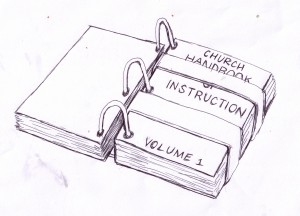
The Church of Jesus Christ of Latter-day Saints (LDS) has announced that a new policy manual will be released on February 19th, 2020. And while an updated policy manual sounds like the most boring kind of news, this is exciting because for the first time, the complete policy manual will be available online for anyone to read.
I know! You’re thinking, I don’t want to read a policy manual. I can’t think of a worse way to spend my weekend.
Stay with me for a minute. I promise not to make you read it, but let’s talk about why it’s important that you can.
For decades, the manual was divided into two volumes, with the first volume, containing about half the policies that govern us as church members, only accessible to designated church leaders. And when I say “church leaders,” I am almost exclusively talking about men. At one point, I researched the numbers of men and women within the church with access to this sealed policy manual, and found that over 100,000 men had access, while only nine women within the entire worldwide church were allowed to read it. This lack of transparency meant that women had to rely on males with authority over them to accurately implement and disclose church policy, leaving women vulnerable in several situations that could intimately affect their lives.
For example, a woman could not read for herself the steps required to change her own marital status within the records of the church. If a woman was denied her request for a temple marriage or divorce, she could not know if her request was denied on the basis of policy or because of a local leader’s personal whims.
Church discipline policies were also hidden within the sealed book. If a priesthood leader overstepped his authority in punishing a woman, she could not know that he had crossed a line. Even in cases in which church policy was strictly observed, coming into a disciplinary council without knowledge of the rules and protocols added an extra layer of unnecessary trauma to the proceedings.
About five years ago, I completed a comprehensive analysis of the effects of church policy on women, using a bootlegged copy of the secret handbook as reference. After receiving my report, LDS church employees invited me to church headquarters to talk about my results. One of them asked me, of the many policies I had recommended changing in my report, where would I start? What would be the first change I would make?
I told them I would begin with transparency. A recurring problem within church policy is that policies are biased toward protecting men in power instead of the vulnerable people they serve. This bias is a natural result of only allowing men in power to participate in policymaking or even read the policies that result from the process.
Moreover, I added, this change would be a low hanging fruit. It would be easy, inexpensive, and quick to simply upload the policy manual to the website. It would be a giant step for women, completed within a few keystrokes.
The people I spoke with at church headquarters told me that going public with the manual was not simple at all. They said there were concerns that if the policies were accessible, the church would be held liable if local leaders were inconsistent in following them and did not grant church members the due process promised in policy.
Local leaders, who are unpaid and largely untrained, certainly are inconsistent in following church policy, but ironically, there was very little due process promised in the policies I read in that sealed book. At the time I read it, the manual gave almost unlimited power and protection to male priesthood leaders, often at the expense of women and other vulnerable people in their congregations.
A new commitment to transparency will be the first step toward combating this problem. In the past, a woman could not argue that a policy was unjust without disclosing that she had violated church rules by reading an illicitly distributed copy of the policy manual. Now that we have access, I hope that we will inundate church leaders with feedback about policies that affect our lives and demand change where change is needed.
Which brings me to one last point: if you do decide to explore that boring manual, you are likely to read policies that upset you. You might even wonder if the saying is true, “Ignorance is bliss.” You will read unwelcome advice and mandates from anonymous church policymakers and might wish you hadn’t known that the church had so many opinions about your private life.
Before you start browsing the newly public policy manual, I want to bear testimony to you that the policy manual was not written like the Ten Commandments, with God’s own finger. Like nearly every other policy manual, it was written by committees of mostly well-intentioned but flawed people who were limited by their own biases. Contrary to best practice, which calls for diverse and representative policymaking teams, these committees were probably exclusively male, and those men were largely homogeneous in age, race, nationality, sexual orientation and other demographics. Don’t feel obligated to overrule your own personal inspiration because some anonymous committee doesn’t like it.
But do consider raising your voice when you encounter a policy that needs a rewrite or a delete. The diverse perspectives of all us are exactly what the church needs. Now that we can see the book, we can work toward making it better.






11 Responses
Thank you! Thank you! Thank you!
I agree with everything you said. I have wanted to read Handbook 1 for years, especially after my first run-in with policies that barred women from filling a non-priesthood related role. I am interested to see if any of the language will change from what we had in 2019 to 2020 when it is published. Will certain policies be quietly rewritten? Quick question that I’m honestly just seeking an answer to: What current policies protect the leaders instead of the people they serve?
I can’t definitively speak about current policy, because the most recent Handbook I had access to was dated 2010. (We’ll all see the new one in a few days!) But here are some posts I wrote about the 2010 policies regarding policies that were biased toward protecting those in power rather than those without:
Protecting the Vulnerable: https://www.the-exponent.com/protecting-the-vulnerable-a-values-based-approach-to-woman-friendly-policy-in-the-lds-church/ and if you look in this table under “Protecting the Vulnerable” you will see a comprehensive list of 2010 policies that did not meet this standard: https://www.the-exponent.com/policies-a-values-based-approach-to-woman-friendly-policy-in-the-lds-church/ Thankfully, quite a few of these have since changed!
Church discipline is a particularly problematic area of church policy with regards to lack of transparency and protections/due process for the vulnerable, with many church policies designed to make the process easier for church leaders and/or reduce liability for church leaders at the expense of making the process less fair and more traumatizing for the accused. Here are a few posts I have written about that (again, based on the 2010 handbooks):
https://www.the-exponent.com/coercion/
https://www.the-exponent.com/church-discipline-women-disciplined-by-men/
https://www.the-exponent.com/five-more-lds-church-discipline-policies-that-affect-women-unequally/
Failing to include informed consent protocols in the temple and within the church interview process is another example of an area in which basic protections for the vulnerable which are standard in other arenas are ignored in the church:
https://www.the-exponent.com/introducing-informed-consent-to-bishops-interviews/
I love this list. Informed consent is a glaring omission that definitely needs to be remedied. I wasn’t granted any informed consent before trusted relatives and leaders pressured me into the nude temple ordinance with strangers, and that act left me very shaken, scared, and traumatized. I was only asked about free will and choice after the deed had been done.
I applaud the transparency. It is about time. However, now as much of a moving target as ever, constantly being updated. It reminds me so much of the added upon laws of the Jews. Pretty soon we won’t be able to take more than 2,000 cubits on Shabbat.
I think they will reserve the most sensitive and controversial policies for church HQ and their law firm. I dont think the leadership in SLC will be as transparent as they are trying to seem with this announcement. Based on how reluctant they are to grant women any real authority (we still only share privileges granted to children) I truly doubt they would give us access to informarion about the deeply sensitive stuff that can really impact us. Just as they did with the permission to be witnesses alongside children, they will throw us a bone to try to keep us happy, but in their back rooms they will most definitely have held back policies and rules that only upper echelons of male leaders and male lawyers for the church are allowed to view
I love your post, but I’m totally floored at this part,
“They said there were concerns that if the policies were accessible, the church would be held liable if local leaders were inconsistent in following them and did not grant church members the due process promised in policy.”
The church didn’t want to be held liable for when their local leaders failed to act according to stated church policy?!? And the solution to that was to make the policies secret and obscure incidents of abuse, error or overreach? Good heavens.
Here’s hoping the transparency in the handbook will lead to more public accountability and thereby more careful leadership choices by the lay clergy among us.
Note that you will not see what was in the “sealed” handbook. According to the church announcement, the policies are being heavily updated to reflect a “new tone and approach”. In a few days you will have access to 9 out of an eventual 38 chapters of the new general handbook. The remaining 29 chapters will be updated and made available over the next couple of years. They say about 80% of the content of the existing handbooks will be included in the new handbook. What will happen with the remaining 20% of the content? I suspect it will be moved to other smaller “sealed” specialized handbooks, but we will never know.
Good points. Hadn’t realized that. Guess this is what happens when a church becomes a corporation. I don’t think that Jesus had this in mind at all when he preached his gospel of “repent and come unto me.”
What! So what’s the point in releasing the information at all? (Don’t get me wrong, I want as much info as I can get!) Why announce the publication of the handbook if they’re only releasing certain, updated sections?
If you haven’t seen this already.
https://newsroom.churchofjesuschrist.org/article/new-general-handbook